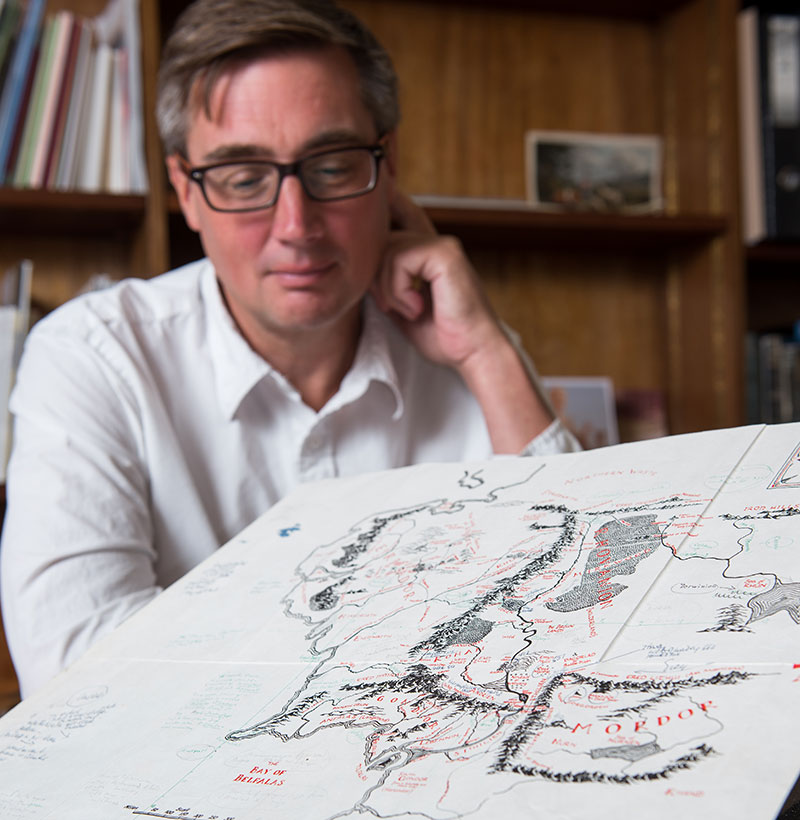The Bodleian Library has recently acquired a rare, annotated map of Middle-earth, the fantasy world setting for J R R Tolkien’s novels The Hobbit and The Lord of the Rings. The acquisition was made possible thanks to generous support from the V&A Purchase Grant Fund, the Kenneth Rose Fund and the Friends of the Bodleian.
For Tolkien, maps played a central role in storytelling, and in enriching the authenticity of his imagined world. ‘The whole idea of place was very important to him, and to the kind of early literature in which he was interested’, explains Dr Christopher Fletcher, Keeper of Special Collections at the Bodleian Library. ‘Whether it was Piers Ploughman or Beowulf, it was an important medieval motif: the question of how different landscapes, real or imagined, actual or symbolic, might relate to one another.’
This rare piece of Tolkien ephemera captures many of the same preoccupations, and provides direct insight into the author’s creative imagination, his conception of Middle-earth, and its relationship to the real world.
Based on earlier designs by Tolkien’s son Christopher, the map was extracted from an edition of The Lord of the Rings in the late 1960s, and served as a working document – used by Tolkien and illustrator Pauline Baynes to develop a new poster depicting Middle-earth.
This map shows us just how specific he was in his conceptions of this world – it wasn’t just dreamt out of nothing.Dr Christopher Fletcher
Tolkien was at pains to ensure that everything was drawn accurately. ‘This map shows us just how specific he was in his conceptions of this world – it wasn’t just dreamt out of nothing’, says Dr Fletcher. His annotations were written in pencil and green ink, and he instructed Baynes on everything from topography, to creatures, climate and heraldry.
Tolkien’s geographical notes, for instance, tell us that ‘Hobbiton is assumed to be approx. at [the] latitude of Oxford’, while elsewhere he jots: ‘(1400 miles [from Hobbiton]) is about latitude of Jerusalem.’ The annotations were to be used by Baynes to understand the changing landscapes and environment, and to ensure that her depictions of flora and fauna accurately represented the world he had created in his own mind.
Following its acquisition by the Bodleian Library, the map now is now part of the largest collection of original Tolkien manuscripts and drawings in the world – an impressive 580 boxes of archival material in total. ‘It’s important to be able to bring this into public ownership’, says Dr Fletcher, ‘where we can share it through exhibitions and make it available for study.’

But as well as giving scholars the opportunity to understand more about Tolkien’s thought processes and inspirations, it also offers valuable insight into the work of Pauline Baynes, ‘a notable artist in her own right.’ Baynes was the only approved artist to illustrate Tolkien’s works during his lifetime, and following an introduction in 1949, she also went on to work with C S Lewis’ on his Narnia books – a project for which she is arguably considered more famous.
Throughout the course of the project, Tolkien was meticulous in his instructions to her. However Baynes also brought elements of her own creativity to the task. The ten surrounding vignettes (which were, interestingly, not seen by Tolkien before publication) were her own decorative inspiration, as were the illustrations showing the Fellowship and their pursuers in the final map’s header and footer.
Although Tolkien had a long and successful working relationship with Baynes, he also produced many of his own maps, sketches and illustrations, using art to inform his narratives and enhance his vision of Middle-earth. ‘He was modest about his ability but he was actually fantastically adept at drawing and watercolours’, says Dr Fletcher.
Within the Bodleian’s extensive Tolkien collection sit a number of the author’s own artworks, including a watercolour painted for the first American version of The Hobbit, and a ‘wonderfully striking’ image of the dragon Smaug conversing with Bilbo Baggins, whilst perched atop a gleaming pile of treasure. Many of the items will be on show in a major exhibition at the Weston Library in 2018.
Following Tolkien’s collaboration with Baynes in 1969, the map went unseen for decades – only to be rediscovered last year, tucked into a book that Baynes had once owned. Blackwell’s Rare Books offered it for sale, and thanks to generous philanthropic support, the Bodleian was able to add it to its existing Tolkien holdings.
Without benefaction, we simply wouldn’t be able to collect in the way we do. Dr Christopher Fletcher
‘Blackwell’s kindly gave us first refusal on the map’, says Dr Fletcher. ‘I think had we not had the opportunity to be offered it directly, then we may not have been quick enough to actually acquire it.’ Being able to respond swiftly when rare and important items become available underscores just how vital philanthropy is to the library, which seeks to build collections of cultural value in a highly competitive market. ‘We have to have the confidence that we have the funds in order to follow through.’
For Dr Fletcher, the issue is clear-cut: ‘Without benefaction, we simply wouldn’t be able to collect in the way we do.’ Tolkien’s map, for example, could have easily been lost to a private collection or even overseas, had donors not stepped in to help.